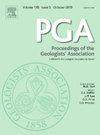英国南部白垩地貌与第四纪景观发展
IF 1.3
4区 地球科学
Q2 Earth and Planetary Sciences
引用次数: 0
摘要
在英格兰GCR地区的中南部和东南部,特别是南北唐斯的突出悬崖和索尔兹伯里平原的广阔高地,垩克兰非常引人注目。白垩地貌最明显的特征之一是密集分布的干谷,这是其倾斜和陡坡的特征。这里考虑了两组干谷遗址,一组是形态学组(布拉顿,魔鬼堤岸和雷克底),另一组以其沉积物(阿沙姆采石场,牛沟,魔鬼揉面槽,霍利韦尔库姆和上大厅)而闻名。在第一组中考虑的山谷的形态是壮观的。每一个GCR站点显然都与河流捕获有关。它们表现出复杂的形态,包括斜坡的断裂,尖锐的角度,显然还有根深蒂固的弹簧。魔鬼堤岸和耙底拥有一般平滑的斜坡,而布拉顿遗址的斜坡被广泛的渠道切割。这些山谷的形成引起了相当大的争议,主要涉及冰川周围条件的程度,而不是“正常”的温带河流条件。第二组Chalkland GCR遗址与相对简单的山谷或海湾有关,在这些山谷或海湾中,自然或人工暴露揭示了复杂的沉积物,这些沉积物提供了详细的环境信息,主要来自软体动物遗骸,但在壮观的Holywell Coombe,也来自花粉和鞘蛉。从牛沟、魔鬼揉面槽和霍利韦尔库姆回收了人类文物。根据常规和AMS放射性碳定年法,除了可能追溯到中德世的上霍尔以外,在每个地点,沉积物所代表的时期都是晚德世到全新世。本文章由计算机程序翻译,如有差异,请以英文原文为准。
Chalk Landforms of Southern England and Quaternary Landscape Development
The Chalklands are conspicuous in the landscape of the south-central and south-eastern England GCR region, especially the prominent escarpments of the North and South Downs and the extensive upland of Salisbury Plain. One of the most obvious features of Chalk landscape is the dense distribution of dry valleys which characterise both its dip and scarp slopes. Two groups of dry-valley sites are considered here, a morphology group (Bratton, Devil’s Dyke, and Rake Bottom), and a group noted for its sediments (Asham Quarry, Cow Gap, Devil’s Kneadingtrough, Holywell Coombe and Upper Halling). The morphology of the valleys considered in the first group, is spectacular. Each of these GCR sites is apparently associated with river capture. They display a complex morphology involving breaks of slope, sharply angular courses and, apparently, entrenched springs. Devil’s Dyke and Rake Bottom possess generally smooth slopes in contrast to the Bratton site where the slopes are incised by a wide range of channels. The formation of these valleys has attracted considerable controversy, mainly concerning the degree to which periglacial conditions, rather than ‘normal’, temperate fluvial conditions, are involved. The second group of Chalkland GCR sites is associated with relatively simple valleys or embayments in which natural or artificial exposures have revealed complex sediments that provided detailed environmental information, mainly from molluscan remains, but also from pollen and coleoptera in the case of the spectacular Holywell Coombe. Human artefacts were retrieved from Cow Gap, Devil’s Kneadingtrough and Holywell Coombe. At each site except perhaps Upper Halling where the record may extend back to the Mid-Devensian, the period represented by the sediments is late Devensian to Holocene time, according to conventional and AMS radiocarbon dating.
求助全文
通过发布文献求助,成功后即可免费获取论文全文。
去求助
来源期刊
CiteScore
2.70
自引率
8.30%
发文量
54
审稿时长
6-12 weeks
期刊介绍:
The Proceedings of the Geologists'' Association is an international geoscience journal that was founded in 1859 and publishes research and review papers on all aspects of Earth Science. In particular, papers will focus on the geology of northwestern Europe and the Mediterranean, including both the onshore and offshore record. Following a long tradition, the PGA will focus on: i) a range of article types (see below) on topics of wide relevance to Earth Sciences ii) papers on aspects of Earth Science that have societal relevance including geoconservation and Earth management, iii) papers on palaeoenvironments and palaeontology of the Mesozoic and Cenozoic, iv) papers on aspects of Quaternary geology and climate change, and v) papers on the history of geology with particular reference to individuals that have shaped the subject. These topics will also steer the content of the themes of the Special Issues that are published in the PGA.

 求助内容:
求助内容: 应助结果提醒方式:
应助结果提醒方式:


